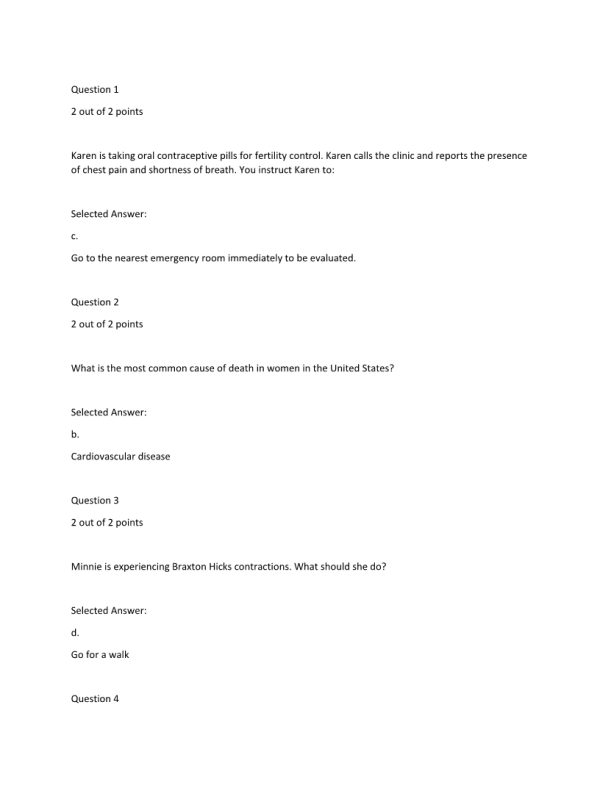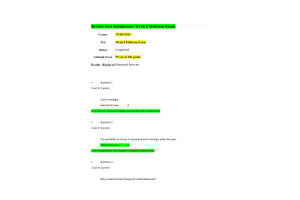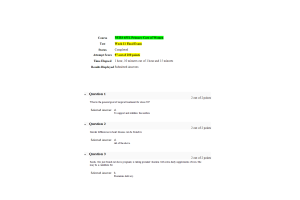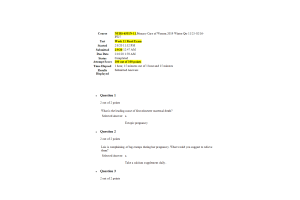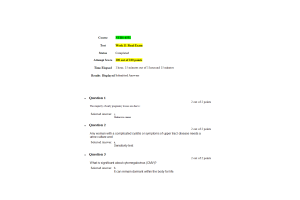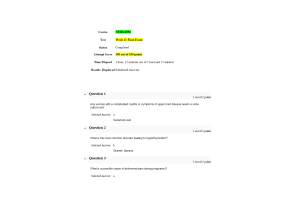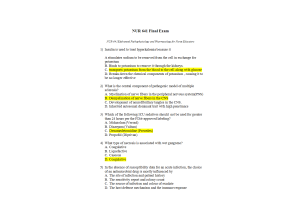NURS 6551 Week 11 Final ExamSpring Term
- $39.00
- Question: Karen is taking oral contraceptive pills for fertility control. Karen calls the clinic and reports the presence of chest pain and shortness of breath. You instruct Karen to:
- Question: What is the most common cause of death in women in the United States?
- Question: What is the term for a postpartum disorder in which bacteria ascend from the lower genital tract and infect the uterus?
- Question: What is the term for a postpartum disorder in which bacteria ascend from the lower genital tract and infect the uterus?
- Question: At what time during pregnancy does nausea typically occur?
- Question: According to Naegele's rule, if a woman's last normal menstral period (LNMP) was September 23, what is her estimated date of delivery?
- Question: Which of the following maternal situations is considered an absolute contradiction to breastfeeding?
- Question: Carrie is due to deliver her second baby. During your work-up, you note that she hemorrhaged after delivering her first baby 2 years ago, has always had menorrhagia, and bruises easily. Her lab work reveals a normal blood work-up, including a normal prothrombin time and activated partial thromboplastin time. What do you suspect?
- Question: When is round ligament pain most likely to occur in pregnant women?
- Question: Heather, who is 5 weeks pregnant, is nauseous. She asks you how long this will last. You tell her nausea usually disappears by the
- Question: Patricia presents for her regularly scheduled prenatal visit at 34 weeks' gestation. During the interview, you determine that Patricia has not felt fetal movement for the past week. On examination, you are unable to auscultate the fetal heart tones. Which of the following would be useful in the diagnosis of an intrauterine fetal death?
- Question: Mildred is 6 months pregnant and presents with symptoms of urinary frequency, urgency, dysuria,and suprapubic discomfort. Her urine is cloudy and malodorous. She has no fever, chills, nausea, or vomiting. What is your diagnosis?
- Question: What is the leading cause of first-trimester maternal death?
- Question: Ginny, who is planning on getting pregnant, is taking phenytoin (Dilantin). She states that she knows the drug is in category D and asks what that means. You know FDA category D indicates that
- Question: A 28-year-old pregnant patient gives a history of smoking 1 pack of cigarettes per day (1 PPD). The nurse practitioner is accurate when she tells the patient that cigarette smoking is associated with:
- Question: What is the rationale for anemia seen throughout gestation?
- Question: A 22-year-old patient has a single, nontender, freely movable lump in her right breast.She denies any nipple discharge. Which of the following diagnosis is this clinical presentation most consistent with?
- Question: The treatment(s) with demonstrated effectiveness relieving symptoms of dysmenorrhea in women with premenstrual syndrome is (are):
- Question: A poorly defined, flat, blue-black macule, present at birth and usually on the trunk and buttocks, is a
- Question: What is a common cause of leg cramps during pregnancy?
- Question: Lois is complaining of leg cramps during her pregnancy. What would you suggest to relieve them?
- Question: Which of the following is the best description of the Lamaze method of childbirth education?
- Question: A 19-year-old sexually active female is being counseled by the nurse practitioner about contraception. The nurse practitioner is accurate when she tells the patient that a diaphragm.
- Question: Susie, who is 16 weeks pregnant, is having mild cramps with persistent and excessive bleeding. Upon examination, you find that some portion of the products of conception (placental) remain in the uterus, but the fetus has been expelled. What type of abortion is Susie having?
- Question: What has changed in terms of recommended antibiotic treatment for uncomplicated lower UTIs?
- Question: How are pregnancy-related DHA (docosahexaenoic acid) needs best met?
- Question: Allie, who has asthma, just found out that she is pregnant. She is wondering whether she should continue taking her asthma medications. Which of the following is true regarding asthma and pregnancy?
- Question: What is a fetus's gestational age when its mother's uterus is palpable just above the pubic symphysis?
- Question: A 26-year-old female patient presents with cracked and sore nipples. She is breastfeeding her first child who is 4 weeks old. The nurse practitioner would be accurate to advise the patient to:
- Question: During pregnancy, it is important to be physically active. The nurse practitioner should encourage her pregnant patient who has a very sedentary lifestyle to
- Question: The primary endocrine disorders affecting women are diabetes mellitus and:
- Question: Where does edema tend to occur in the pregnant woman’s body?
- Question: A woman with hyperemesis gravidarum would most likely benefit from a plan of care designed to address which of the following nursing diagnosis?
- Question: What tends to cause acne in adolescence?
- Question: Which of the following recommendations should you provide to parents about reducing the risk of sudden infant death syndrome (SIDS)?
- Question: The Papanicolaou (Pap) smear report on a 36-year-old female patient indicates atypical squamous cells of undetermined significance (ASCUS). Which of the following constitutes appropriate care for this patient?
- Question: Jack and Jill present for a preconception health counseling session. Jack is 34, Jill is 33, and they have a 5-year-old son, Jake. Jake is the product of an uncomplicated pregnancy and labor. At birth, Jake had an open neural tube defect and now has spina bifida with a loss of function of his lower extremities. Jack and Jill want another child and ask if there is anything they can do to prevent the recurrence of a neural tube defect in future pregnancies. What is your best response to this couple?
- Question: During nursery rounds, you examine a 12-hour-old newborn. The infant has a yellow tint to the skin and sclera. What lab test will you order to further evaluate this infant?
- Question: What is the most typical schedule of prenatal care in the first 28 weeks of pregnancy?
- Question: A 40-year-old female presents for a routine well woman exam. On examination, the nurse practitioner notes a scant nipple discharge, absence of a palpable mass, and absence of lymph node enlargement. Which of the following is the most likely diagnosis?
- Question: What is the most common type of UTI that affects women?
- Question: Which of the following dietary changes would you recommend Heather, who is experiencing nausea during her first trimester?
- Question: A 25-year-old obese female has a history of frequent candida vaginal infections in the past year. She is in a monogamous sexual relationship and uses and intrauterine device (IUD) for contraception. Of the following, which is the most likely underlying condition predisposing her to recurring candida vaginitis?
- Question: A 24-year-old female insists of having a screening mammogram. Upon further questioning, the nurse practitioner discovers the patient is concerned about breast cancer because her mother has fibrocystic breast disease. The nurse practitioner would be accurate if she tells the patient that the major risk factor for development of breast cancer in women is:
- Question: What is the term for the craving and purposeful consumption of nonfood items for more than one month?
- Question: In the formula to estimate gestational age, woman are considered pregnant from: ___________________________
- Question: Which of the following drugs should be used with extreme caution in breastfeeding mothers?
- Question: What is a possible cause of abdominal pain during pregnancy?
- Question: An asymmetric, softened enlargement of the uterine corner caused by placental development is a possible sign of pregnancy. What is it called?
- Question: The drug of choice for the pregnant woman with diabetes is
- Question: When completing this quiz, did you comply with Walden University’s Code of Conduct including the expectations for academic integrity?
